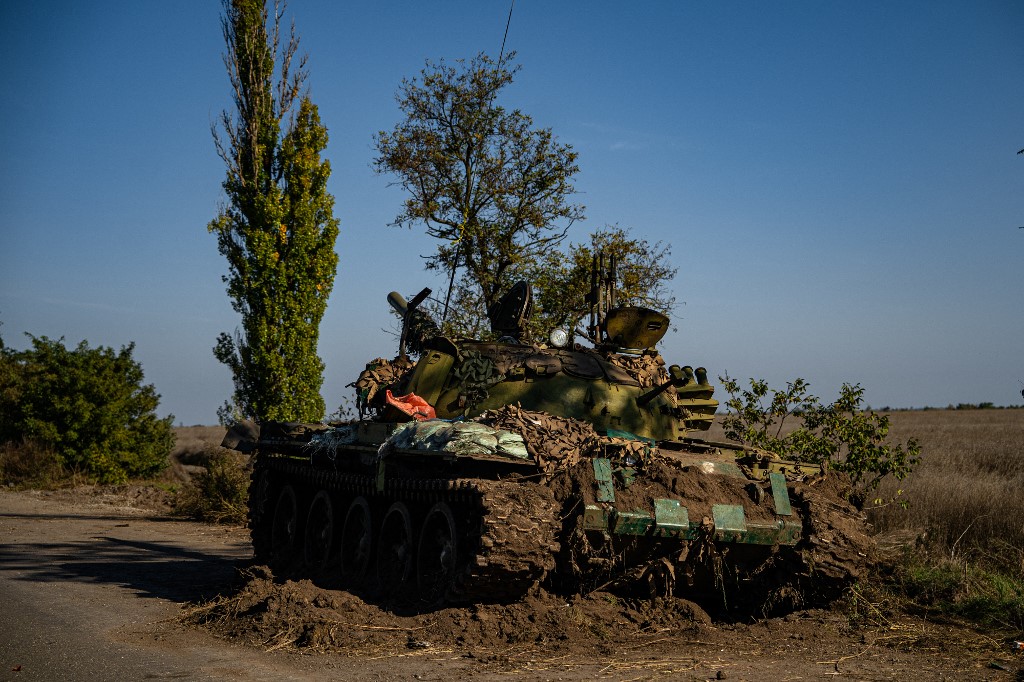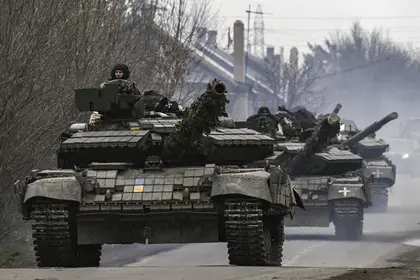The Russian army has shifted over to a full defensive stance which it hopes will allow it to break Kyiv’s upcoming major counteroffensive with a hard-core defense employing air power, extensive fortifications and massed concentrations of men and machines. Analysts and Ukrainian officials feel that a combination of Russian manpower problems and Ukraine’s incoming western equipment won’t make it easy for them.
In the Zaporizhia sector, where the Kremlin most expects heavy Ukrainian armored attacks, Russian forces have constructed three major defensive belts of entrenchments and minefields, publicly-released Ukrainian army intelligence estimates and open-source analysts say.
JOIN US ON TELEGRAM
Follow our coverage of the war on the @Kyivpost_official.
Some trench-lines, particularly in the vicinity of the key road and rail nexus city of Tokmak, extend for dozens of kilometers along high ground, with prepared bunkers built at highway intersections, dragons’ teeth concrete pyramids barriers crossing farm fields and anti-tank ditches.
Andriy Usov, a Ukraine army military intelligence specialist told KyivPost, that the Russian army has halted practically all offensive operations across the entire front line, to focus its manpower and equipment on building the fortifications.
“The Russian occupiers are moving to defense along most of the frontline,” he said. "The enemy is still conducting offensive actions in the frontline on some directions, particularly in Bakhmut and in the east.

Now It’s Time to Pull Together – Surely?
“However, in those areas where the enemy is still trying to advance, losses are unreasonably high,” he added.

A Russian trench in the Zaporozhye region, February 2023. Photo:Ukrinform
Viktor Tregubov, an AFU Major, also told Kyiv Post that Moscow’s military leaders were prioritizing preparations for a Ukrainian assault. Even in the Donbas sector and the beleaguered city Bakhmut, where the Kremlin wants to avoid the political embarrassment of calling its attacks to a total halt, Russian troops have drastically reduced the pace of their assaults, in the hope of reducing casualties.
“The Russian General Staff and Yevgeniy Prigozhin (head of PMC Warner) are already in agreement in calling for a shift to a defensive posture. However, the Kremlin is still setting its forces the goal of reaching the borders of the Donetsk region, however unattainable, so they are now trying to slow down the pace on the ground themselves,” Tregubov said.
Yusov noted that weather conditions also affect military activity, with spring rains muddying the entire front line. “Weather conditions are always the basis for adjusting specific plans and using certain equipment for military operations, he told Kyiv Post. “In the operation of unmanned aerial vehicles or assault operations - the weather is a factor that should be considered.”
On April 25, both the Washington-based Institute for the Study of War (ISW) and the British Defence Ministry daily situation estimate, declared that Russian attempts at major attacks were at an end, because of a Moscow decision to prepare its forces to defend against the upcoming Ukrainian assault.
Public domain satellite images show defensive belts, built not just on the front line blocking the most likely directions for initial Ukrainian assaults, but in hundreds of secondary fighting positions reaching dozens of kilometers into the Russian rear area. This is particularly true along major highways leading from Ukrainian army-controlled territory in the Zaporizhia and Kherson sectors in the direction of the widely-predicted ultimate objective of the attack - Russian-occupied Crimea.

Estimated Russian causalities since Feb.24, 2022.
Military blogger Tom Cooper, in his April 26 posting, commented that these in-depth fortifications could prove to be a key Russian advantage because the Ukrainian army has little experience of attacking prepared defensive positions and almost none in attempting a large-scale assault on fortifications, with the goal of breaking through them quickly.
Russian lines are protected “… by a few million mines, just for the start. The first one might be easy to punch through, but the problem is maneuvering through minefields and into the second line ... The AFU is not yet there in regards of overcoming those kinds of obstacles,” Cooper said.
Ukraine’s Army General Staff (AGS) has periodically reported that its troops were practicing to breach minefields and prepared fortifications, at times using western combat engineer equipment, such as the German Bison mine-clearing tank.
On the other hand, Russian soldier morale is known to be low and an extensive fortification system is of little worth if soldiers are unwilling to defend it, AGS spokesmen have claimed.
Recent evidence of Russia’s problems of finding sufficient numbers of men to defend fortifications surfaced over the weekend. A group of former security guards, from the Russian energy company Gazprom, published a public video in which they claimed they had volunteered to perform rear area protection duties in Ukraine. Instead, they found themselves turned over to Wagner mercenaries who forced them, at gunpoint, to deploy to front line positions in the Bakhmut sector, with minimal weapons and ammunition.

An abandoned Russian T-62 tank pictured south of the village of Novovorontsovka last October after Ukraine's last counteroffensive. PHOTO: AFP
Deploying private hires to the front in order to avoid risking conscripted soldiers into major cities is a longstanding Kremlin policy. Evgeniy Linin, a military “correspondent”, closely associated with the Wagner group, accused the Gazprom fighters of cowardice and betrayal.
“The Gazprom security group abandoned positions, obtained with the blood of Wagner fighters, to the Armed Forces of Ukraine and fled from the front line. The [Gazprom fighters] consider the justification for its actions to be that they are volunteers … well done. With such friends, you don’t need enemies!” Linin wrote in a Telegram statement on April 25.
According to Anton Herashchenko, a Ukrainian Interior Ministry official, the occupying Russian authorities in Dnipro left bank villages have been warning civilians to prepare for evacuation since mid-April and not to report Russian troop movements in the vicinity.
Ukraine’s AGS has noted, in daily situation estimates, an almost total absence of Russian air force attempts to cross into UAF-disputed air space in April. The move may be a conscious decision to hold back its air assets to take on the upcoming Ukrainian attack, with the leverage that the Russian air force’s powerful numerical and qualitative advantage gives over the Ukrainian air force.
But, analysts said, more careful Russian military air operations could also be Kremlin’s acknowledgement that the first US-made Patriot air defense battery had reached Ukrainian territory and had become operational on Sunday April 23. The system is primarily deployed to protect “strategic targets”, such as nuclear power stations, Ukrainian air force spokesman Yuri Ihnat said in a statement.
You can also highlight the text and press Ctrl + Enter










